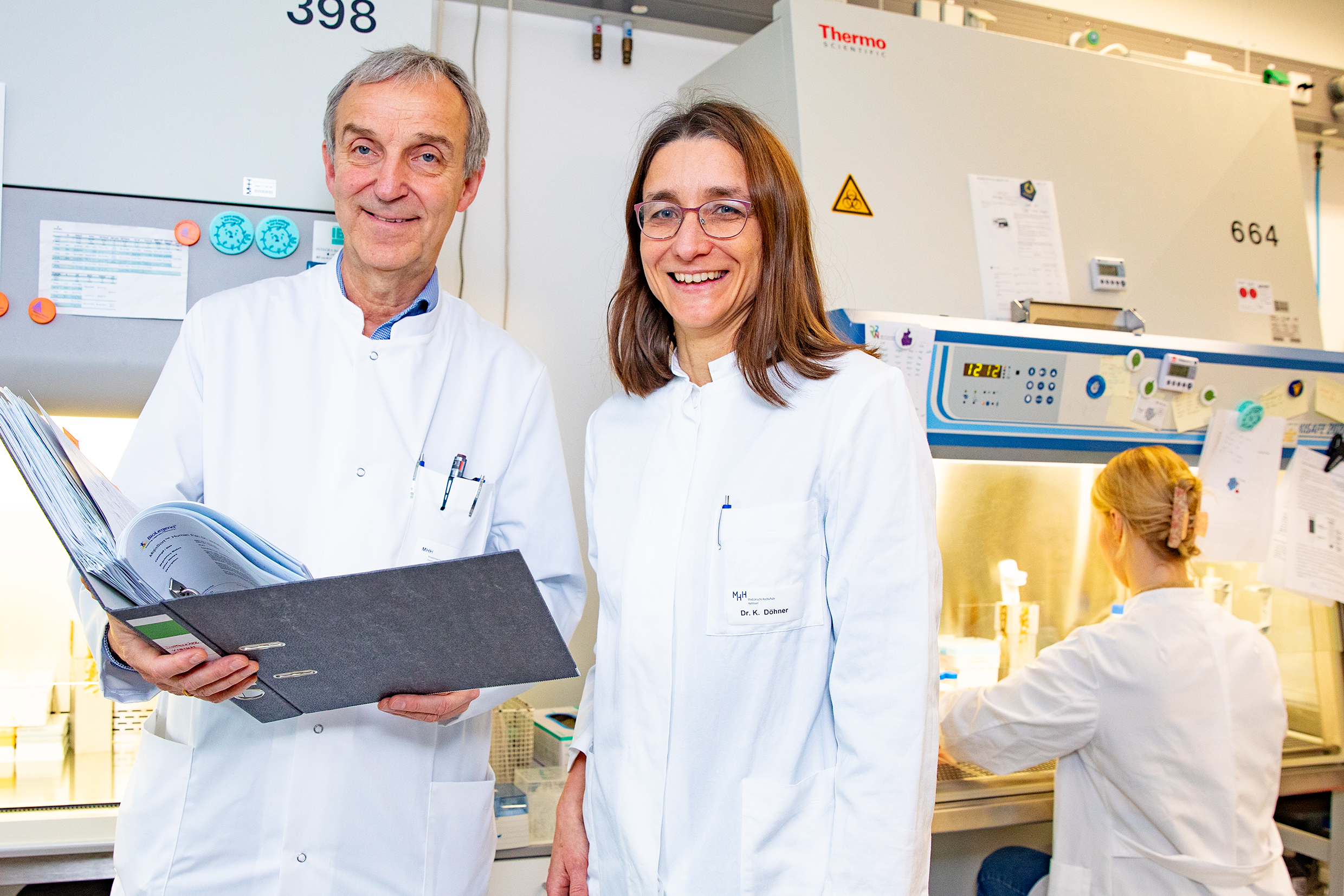Study participants wanted: MHH cooperation project investigates the role of the antimicrobial protein RNase 7 in the defence against herpes simplex and varicella zoster viruses.

They want to clarify the role of RNase 7 in the defence against viruses on the skin: Professor Dr Thomas Werfel and Dr Katinka Döhner. Copyright: Karin Kaiser / MHH
![[Translate to Englisch:] Copyright: Karin Kaiser / MHH [Translate to Englisch:] Eine Hand drückt einen Plastikzylinder auf einen Arm, eine andere Hand hält eine Pipette.](/fileadmin/mhh/presse/MHH_Insight/2024/240527P_RNASE7_1.jpg)
[Translate to Englisch:] Mit Hilfe des Spülzylinders werden die antimikrobiellen Proteine und Peptide aus einem kleinen, definierten Hautbereich gewonnen. Copyright: Karin Kaiser / MHH
Our skin forms an important barrier against pathogens. The first line of defence includes so-called antimicrobial proteins and peptides (AMP) of the innate immune system, which are formed in the upper layers of the skin. One of these AMPs is called RNase 7 and attacks various bacteria and fungi. The fact that RNase7 is also active against herpes simplex viruses (HSV) was recently discovered by the research group led by Professor Dr Thomas Werfel, Director of the Department of Dermatology, Allergology and Venereology at Hannover Medical School (MHH). Herpes simplex viruses belong to the alpha herpes viruses and usually cause mild symptoms such as cold sores. However, recurrent infections of the eye can also lead to scarring of the cornea and thus to impaired vision. They can also cause severe, widespread infections on the skin, known as eczema herpeticatum. In the RESIST Cluster of Excellence, Professor Werfel is researching, among other things, the question of which mechanisms lead to such severe disease progression after herpes infections in people with atopic dermatitis.
Studies on patients from the HSV cohort established in RESIST and from the German atopic dermatitis register have shown that 22 per cent of patients with moderate to severe atopic dermatitis have suffered from eczema herpeticatum at least once. In cooperation with the Department of Dermatology at the University Medical Centre Schleswig-Holstein, the MHH Institute of Virology and the MHH Institute of Toxicology, Professor Werfel and his colleague Dr Katinka Döhner now want to find out what role RNase 7 plays in the increased susceptibility of this subgroup of neurodermatitis sufferers. The German Research Foundation is funding the project with around 750,000 euros. The MHH will receive 460,000 euros of this amount.
Clarifying molecular mechanisms
The researchers have been investigating the effects of antimicrobial peptides on the skin for a long time. "In this context, we were able to show that free DNA, which is increasingly detectable on inflamed skin in atopic dermatitis, leads to a weakening of the antimicrobial effectiveness of RNase 7 and other AMPs," says Professor Werfel. "In addition, our colleagues in Kiel, in cooperation with us, have discovered that a protein that inhibits RNAse 7 is produced more frequently in the skin of atopic dermatitis sufferers." However, it is not yet clear whether the greater susceptibility to herpes viruses is due to the fact that those affected simply have less RNase 7 available on their skin at the onset of herpes infections than healthy people or whether the protein's attack against the viruses is weaker in them. To this end, biochemist Dr Döhner wants to elucidate the molecular mechanisms of RNase 7. The investigations are being carried out on human keratinocyte cultures, specialised cells from the epidermis, the outer layer of the skin. The researchers check the AMP concentration on the skin by repeatedly rinsing a small, defined area of skin with a saline solution containing soap using a so-called rinsing cylinder.
Testing activity against related chickenpox virus
On the one hand, the researchers want to understand which steps in the infection process are inhibited by RNase 7 and with which viral and cellular factors RNase 7 interacts. Secondly, they want to find out whether there are differences in the formation, release and activity of RNase 7 and other antimicrobial proteins between atopic dermatitis patients with or without eczema herpeticatum and people with healthy skin. "We are therefore also investigating whether the antiviral activity of RNase 7 is actually inhibited by an RNase inhibitor," says Dr Döhner. The researchers also want to investigate whether RNase 7 is also active against varicella zoster viruses, which are related to herpes simplex viruses. These pathogens, which also belong to the alpha-herpesviruses, cause chickenpox in children and can cause shingles after reactivation in adults - often in older people.
Possible supplement for antiviral agent
The two alpha-herpesviruses investigated in the project "hide" in the body, so to speak, and thus escape destruction by the immune system's defence cells. "We often find antibodies in atopic dermatitis sufferers, but these are clearly not enough to protect them," says Professor Werfel. "Since we now know that RNase 7 is active against herpes simplex viruses, we assume that this direct attack is an important mechanism in people with healthy skin." Severe herpes simplex infections are therefore treated internally with the active ingredient acyclovir, which stops the virus multiplying in the body's cells. Another drug for internal use (pritelivir) is currently undergoing clinical trials. If the researchers can elucidate the role of RNase 7, the antimicrobial protein could potentially be a useful addition to this antiviral therapy in the future - for example as an additive in creams and ointments.
Study participants wanted
Subjects are still being sought for the study. Patients with known neurodermatitis and a history of at least one episode of severe herpes infection that had to be treated internally can take part. To register, please call (0511) 532-5086. More information on the clinical studies in the field of immunodermatology and experimental allergology can be found here.
A summary of the original work on the inhibition of RNase 7 on the inflamed skin of atopic dermatitis sufferers „Inhibition of RNase 7 by RNase inhibitor promotes inflammation and Staphylococcus aureus growth: Implications for atopic dermatitis“ can be found here.
Text: Kirsten Pötzke